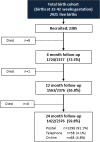Telephone interviews and online questionnaires can be used to improve neurodevelopmental follow-up rates
- PMID: 24716630
- PMCID: PMC3983863
- DOI: 10.1186/1756-0500-7-219
Telephone interviews and online questionnaires can be used to improve neurodevelopmental follow-up rates
Abstract
Background: Maximising response rates to neurodevelopmental follow-up is a key challenge for paediatric researchers. We have investigated the use of telephone interviews and online questionnaires to improve response rates, reduce non-response bias, maintain data completeness and produce unbiased outcomes compared with postal questionnaires when assessing neurodevelopmental outcomes at 2 years.
Methods: A prospective cohort study of babies born ≥32 weeks gestation. Neurodevelopmental outcomes were assessed at 2 years of age using a parent questionnaire completed via post, telephone or online. Relative Risks with 95% confidence intervals (RR; 95% CI) were calculated to identify participant characteristics associated with non-response and questionnaire response mode (postal vs. telephone/online). The proportion of missing data and prevalence of adverse outcomes was compared between response modes using generalized linear models.
Results: Offering telephone/online questionnaires increased the study response rate from 55% to 60%. Telephone/online responders were more likely to be non-white (RR 1.6; [95% CI 1.1, 2.4]), non-English speaking (1.6; [1.0, 2.6]) or have a multiple birth (1.6; [1.1, 2.3]) than postal responders. There were no significant differences in the prevalence of adverse neurodevelopmental outcomes between those who responded via post vs. telephone/online (1.1; [0.9, 1.4]). Where parents attempted all questionnaire sections, there were no significant differences in the proportion of missing data between response modes.
Conclusions: Where there is sufficient technology and resources, offering telephone interviews and online questionnaires can enhance response rates and improve sample representation to neurodevelopmental follow-up, whilst maintaining data completeness and unbiased outcomes.
Figures
References
-
- Guillen U, DeMauro S, Ma L, Zupancic J, Roberts R, Schmidt B, Kirpalani H. Relationship between attrition and neurodevelopmental impairment rates in extremely preterm infants at 18 to 24 months: a systematic review. Arch Pediatr Adolesc Med. 2012;166(2):178–184. doi: 10.1001/archpediatrics.2011.616. - DOI - PubMed
Publication types
MeSH terms
Grants and funding
LinkOut - more resources
Full Text Sources
Other Literature Sources
Medical



